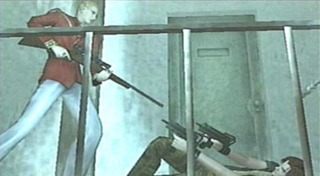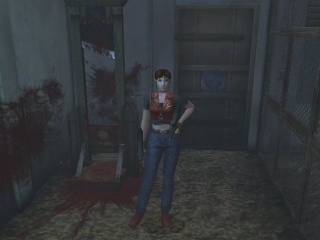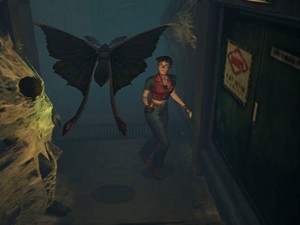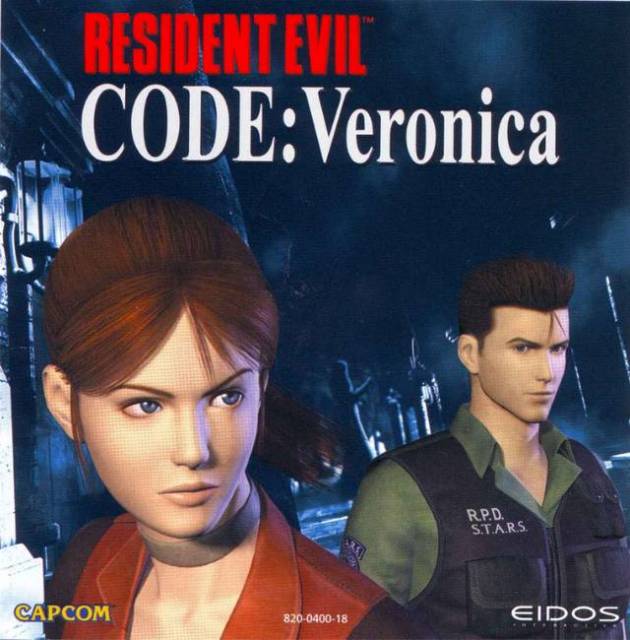All the wrong kinds of moronic.
Xbox Live Arcade has proved an excellent platform for the release of older games. Because these older games are simple to grasp and to emulate on other systems, the platform has become a new opportunity for newer gamers to experience old classics. Yet this certainly does not mean that every game is deserving of rerelease. No game demonstrates this more efficiently than Resident Evil: Code Veronica: X HD. Just about every aspect of the game, from the story to the gameplay to the overall design, feels ludicrously idiotic, making it hard to give a sincere recommendation.

The greatest offense the game presents is in its story. Picking up from the second Resident Evil game, Code: Veronica X follows Claire Redfield in her search for her brother Chris. However, she soon finds herself trying to escape an island prison and deranged aristocrat Alfred Ashford. From here, the plot starts to resemble a poorly executed combination of previous Resident Evil games and Psycho. This much is made obvious from the outright references to Psycho, from shots of a lone mansion on a hill to a very oddly portrayed cross dressing plot twist early in the game. Sadly, unlike Psycho, Code: Veronica X puts very little work into its story, or at least it does not pay off in the end. One of the reasons behind this is the collection of baffling performances. Just about every voice actor puts on an audacious performance, from the appropriately deranged Ashford twins to action movie-esque Chris Redfield. In fact, the only person to avoid this is series mainstay Albert Wesker, who gravitates toward the other extreme of barely putting any emotion into any of his words. Although this can lend the game a purposefully bad atmosphere, it simultaneously robs the story of any potentially powerful moments. Even then, though, these moments would be few and far between, because a greater part of the problem with the story is just the bad structure to the plot. The characters can behave like idiots; several plot elements exist for seemingly no reason; other plot elements just contradict each other; and overall, the story feels like a bad, poorly planned out action movie. Although this lends it a certain charm, it also makes it hard to recommend this game to a wide audience.
One of the more egregious offenses is the addition of Steve Burnside. Although it seems like the writers intended for him to be a sidekick to Claire, the reality is that he serves absolutely no productive role in the story whatsoever. Not only does he do things that Claire has been clearly established as being able to do herself, but in certain instances, he actually actively hinders progress, stalling the plot for a brief instance. Despite this, Claire manages to fall in love with Steve in the most abrupt and out of left field romance subplot in a video game. One of the reasons this feels so out of place is because Steve never gives Claire any reasons to love him, mostly because he has little characterization. Although he disappears for lengthy portions at a time, even when he is present, he shows little development as a person; his personality traits are described in one or two brief lines before the game simply moves onto something else. Despite this, his story still manages to trip over itself, (awkwardly) depicting him as a cold misanthrope in one scene, and in the next, rendering him unable to shoot a simple zombie. But perhaps the worst thing about Steve is that he somehow manages to have the worst voice in the entire cast. He sounds like a whiny ten year old from a bad Saturday morning cartoon. This only serves to magnify his worse qualities, easily making him the worst character in the entire cast.

The actual gameplay does not fare much better than any of the story elements. Part of this is the combat, which becomes more of an exasperating chore than anything resembling terror. The entire game is littered with zombies and other monsters that want you dead, but it is often unwise to shoot every last one. After all, ammo is limited and is often best saved for more troublesome encounters. This means that many encounters (at least against low-level zombies) devolve to frantic knife fights and shaking the undead off Claire. While this tries to convey the right atmosphere of horror, other factors keep it from reaching its true potential. On the whole, enemy AI is easy to exploit, as making wide turns around them allows for easy escape. Even when escape is not possible, this still holds true; a few shots will place many enemies on their backs, allowing for quick knife stabs. At this point, encounters become dreadful not because of any horror element, but because of how chore-like they become. It does not help that some enemies refuse to stay dead, in certain areas. Similarly, many of these complaints could just as easily be applied to Code: Veronica X’s boss battles. About half of them can be ignored altogether with very little challenge, and the other half are not particularly challenging. In fact, with the right weapons and ammo, they can end in a few seconds, robbing them of any dramatic qualities they may have had otherwise.
The puzzles are even worse, possibly because they constitute the majority of the experience. What makes them so bad is just how esoteric and mentally unbalanced they are. Even the most mundane tasks require unfathomably esoteric solutions, such as opening a door with a glass eye or accessing an emergency plane with three stone keys. Granted, the numerous (and poorly written) journals and files throughout the game acknowledge that these puzzles can be insane, but they never draw any connection between the surreal puzzles and Alfred’s severe mental decay, almost as though this is expected to be normal. Despite this, many of the puzzles prove to be so easy as to become artificial barriers than anything of substance to the game. Because both the problems encountered and their eventual solutions are so unrealistic, it becomes very easy to note which item is used to solve the puzzle(s) at hand. The only major challenge in these scenarios comes from how cluttered the inventory system can become. Arbitrary management decisions aside (healing items never stack, items can never be dropped), Code: Veronica X is very good at overloading your inventory very quickly. The various labs and facilities throughout play host to many different types of ammo and healing items, but they never feel useful when you find them; Chris’ end-game scenario contains far more blue herbs than will ever be necessary (as there are very few poisonous enemies), and Claire can find nearly 200 arrows before finding the gun capable of launching them. This item overload never lets up, leading to a high amount of unnecessary backtracking (added on top of the backtracking that the puzzles themselves already demand), leading to a game that is much longer than it needs to be and enough empty space to eliminate what little horror might have made its way into the game.

Despite these numerous flaws with the game, not everything about it is bad. For example, the graphics perform their job admirably throughout the experience. The most notable aspect about them (at least in terms of the series) is the fact that the game is in full 3D. Although this does not seem important at first (there is no camera control of any kind, and very few weapons have scopes that take advantage of this new feature), it serves a vital role in the telling of the story. Because the camera is not fixed, it is free to move and change between different angles, allowing for flexibility in the story’s presentation. Although it happens to be telling a particularly bad story, the gesture is still appreciated. Yet this does not mean the graphics are not without their own problems. Several of these are minor artistic choices, like lazy animations (characters do not turn so much as statically rotate in place) or general facial modelling/artistic choices. One of the larger faults with the graphics are the CGI cutscenes, which pull off the amazing feat of looking significantly worse than the in-game graphics. The most noticeable reason why is the lack of anti-aliasing. While the game itself is relatively smooth, the pre-rendered scenes are very obviously pixelated and rough. The strange thing about the scenes, though, is that this problem is only in the Xbox 360 releases, as earlier releases fail to demonstrate this. Ignoring these emulation imperfections, though, the CGI still fails to look pleasant. The polygon count does not appear significantly higher than in the regular game, yet somehow, these scenes manage to sport an unnatural plastic look. When combined with their washed out atmosphere, these scenes look like mediocre PS2 games. Although these scenes show up rarely, they still manage to detract from the game’s quality.
Of course, there is not much quality to mar in the first place. In a very concise manner, Resident Evil: Code Veroncia X manages to summarize all the deep faults that plagued the older Resident Evil titles. The story is both poorly thought out and badly executed, replete with unlikeable characters and laughable performances; the combat eventually turns into a bother to be put up with instead of enjoyed; and the puzzles pull off the impossible feat of being both completely illogical and ludicrously easy to solve. True, it is possible to promote this game as enjoyable specifically because of its terrible qualities, but the other, outright bad aspects of the game would make this a difficult recommendation.
